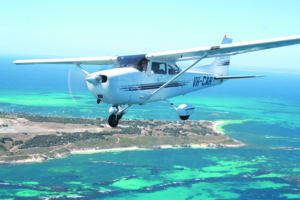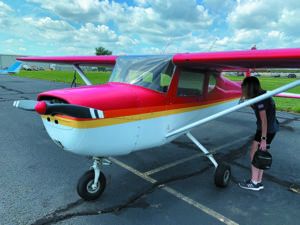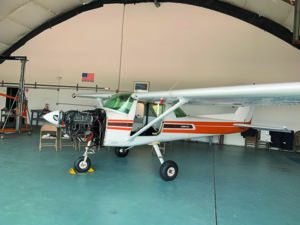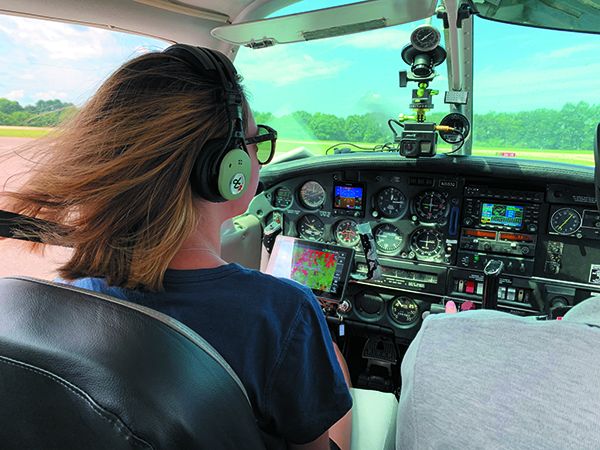We are encouraged but cautious when we learn of impending entrepreneurship in the aviation world. We know that the odds of success for startups are not outstanding, but for those who do their homework and find the right niche, they improve. After all, we know that there is money in aviation—we put a lot of it there.
We’ve noted that in spite of downturns in many segments of general aviation, the last year has been good for a lot of flight schools—we are getting reports that many are having their best year in convenient memory. That has also caused us to hear from CFIs who are exploring starting a one-airplane flight school at airports where there is currently no flight training.
The questions we’ve been getting are whether it’s possible to set up and run a single-airplane flight school—along with what pitfalls to expect as we’ll as how to make it a financial success.
As we researched the matter, we found that successful flight schools had some things in common: airplanes in good shape, a syllabus with tracking of student performance, an air of enthusiasm among employees and students, newer or refurbished airplanes that were kept attractive, respect for the customer and pricing that meant corners weren’t being cut on maintenance.
Our conclusion—a one-airplane flight school can work, but the CFI may need other employment to make ends meet.
NUMBERS
We’ll talk potential airplane in a moment, but let’s start with debt service on a $100,000 machine. Assuming a 20 percent down payment, the annual payments on a 20-year loan will be $6000 to $7800, we’ll use $7000. We’ll budget $8000 for commercial hull and liability insurance, $20,000 for maintenance—including 100-hour inspections—and $38,400 for fuel, assuming 80 hours a month usage of the airplane (960 hours a year) at eight GPH and five-dollar fuel. Engine overhaul will be needed after just over two years, so we’ll set aside $15,000 for engine and prop overhaul. Hangar and office space prices are kind of a roll of the dice, but we’ll try for a middle ground at $7000 per year—although it might be less at an underserved airport. However, the space available to you may need some investment to make it usable.
We used $60,000 for salary for a CFI making this a full-time business. That’s probably light if the person wants to keep doing it as a profession, but the numbers were really starting to add up.
We probably missed incidentals and we didn’t figure in health insurance, but that still put us in the $155,000 per year ballpark. That means averaging about $161.50 per hour of income per hour of usage of the airplane to cover the expected costs. It should help that a healthy percentage of the flight time of the airplane will include dual instruction, for which we think the CFI’s time is worth at least $75 per hour.
The CFI is going to be incredibly busy handling everything involved in the business and we doubt whether it can be done without at least a part-time employee or two.
If we drop aircraft usage by half, to 40 hours per month, the maintenance numbers drop by something less than half, overhaul numbers by half and fuel by half. The fixed costs of insurance, office and hangar space, payroll and debt service stay the same. The total comes down to approximately $120,000. At 480 hours for the year on the airplane, it has to generate $250 per hour. We think that’s going to be challenging, although assuming the airplane is a TAA, concentrating on marketing for specialized training that involves a high percentage of dual instruction and charging what an experienced, professional instructor is worth, it’s not impossible.
At 40 hours a month on the airplane, it also means that the single CFI has a fighting chance of running the business single-handedly without burning out.
AIRPLANES

Naturally, when someone decides to start a single-airplane flight school the discussion regarding the appropriate airplane can go on without end. Our consideration was for an airplane that can be flown by almost any pilot, is easy to maintain/repair and can be used for special mission training that can draw a clientele beyond people interested locally. We ruled out all two-place airplanes because of weight, range and lack of the overall utility needed for a flight school where the airplane has to be nearly everything for everybody.
In the four-place world we think that the Piper Warrior and Archer as we’ll as the Diamond DA40 could be successful.

After running a lot of numbers, our recommendation is the Cessna 172 because it’s the airplane that everybody flies without too much difficulty, every maintenance tech on the planet has probably worked on one, parts are easy to get, there is a range of powerplants available to suit the needs of the locale and it has two doors for emergency egress.
If the location is right, a 172 is tough enough and realistic for backcountry training.
We recommend against selecting a tailwheel airplane. While we think a self-respecting flight school should offer tailwheel instruction, we have consistently observed that those are the airplanes most likely to be wrecked by renters and that have the least demand. They sit while the 172s fly.
If your school is going to be a “no-solo” school for specialized training, a tailwheel airplane is fine. Your challenge will be to generate adequate demand to make it pay. We have seen it done successfully in a number of instances, particularly with aerobatic and backcountry instruction.
TAA
It’s our firm opinion that the airplane should meet the criteria of a Technically Advanced Airplane (TAA) by the time it goes on the line. That means either buying one with the required electronic primary flight display, electronic multi-function display with moving map and integrated, two-axis autopilot or having the boxes installed to bring a non-TAA airplane into compliance.
We think that it is essential to be able to offer TAA training for a single-airplane flight school to be successful. It allows commercial students to do all of their training in the airplane, a big plus, and it is perfect for instrument students. We have observed a market for dedicated glass cockpit or Garmin G1000 training courses. Offering a flat-rate glass transition course can potentially bring in customers who are considering buying a TAA or want to get into flying glass in a total immersion manner. We also think that flat-rate courses can be more lucrative to schools than by-the-hour training.
MAINTENANCE

Any extended downtime on the airplane will be a killer. That means you will have to find a way to get scheduled and unscheduled maintenance performed quickly. Because the airplane is being used for hire, it must have 100-hour inspections, which are essentially the same as an annual inspection. With nothing wrong, it should not take more than two days for one technician to carry out. A problem at underserved airports is finding maintenance. That problem has to be solved before the airplane goes on the line.
Students and renters bend airplanes. You’ll need a Plan B for when a student loses it in a crosswind and causes major damage but not so major that the airplane is totaled (it’s often faster to replace an airplane than repair it). Can you lease something to tide you over if the airplane is down or does it mean shutting down?
INSURANCE
Plan on insurance for a training airplane to be three times what you would pay if you were using the airplane for purely personal use. That’s according to Jon Doolittle of Sutton James Optisure Risk Partners, and Aviation Consumer’s insurance editor. He also said that it will probably be impossible to obtain a “smooth” policy. Your “million dollar” policy will be limited to $100,000 per person injured.
Deciding if you can buy enough insurance to meet your needs means you may want to spend some money with an aviation attorney as you set up your business and decide on the appropriate type of business entity it should be.
RENTAL AGREEMENT
Part of protecting yourself and your school will be putting together a suitable rental agreement that your clients sign and that spells out your and their responsibility. You may also want to require that renters who solo the airplane have renters insurance in place (and can prove it to you) before flying without you in the airplane.
SYLLABI
We suggest that you have a printed and electronic syllabus for each rating and training course you offer in place prior to starting operations. It allows you to show a prospect precisely what is offered—and expected—in training. Each syllabus should have a companion, computer software progress tracking system to allow you and your student to track where they are during training (with honest progress assessments)—important on many levels including protecting yourself should there later be questions about the training. In addition, the system can generate an alert when a student hasn’t flown in a while so that you can call and suggest they come in for their next lesson. We’re advised that such a system helps increase the likelihood that a student will complete a course—which helps keep your school healthy. Successful students bring in more prospects.
SCHEDULING
Aircraft scheduling is a drain on your time that you don’t need, so we recommend using aircraft scheduling software such as Flight Circle (www.flightcircle.com) that allows your customers to directly schedule you and the airplane, and you to manage the airplane, its maintenance, your time as an instructor and billing customers.
BOOKKEEPING
Keeping records is where a number of small flight schools go off the rails and crater financially. We recommend using a professional payroll service—for less than $30 per month per employee they’ll make sure you get paid, employment taxes get deducted and paid and all things payroll are ready for your accountant—or accounting software—at the appropriate time.
We’ll note that if you do take on a part-time CFI, that because of the nature of the job and standardization in flight instruction, it’s likely that your state will require that the person be an employee rather than an independent contractor. That’s where a payroll service can help you stay in the straight and narrow should an official someone ask you questions about taxes.
THE OTHER STUFF
You’ll need to go through the appropriate training and keep records for Homeland Security as we’ll as comply with the document review and record keeping for domestic and international students. We recommend that you put a system in place that alerts you to comply with the regulations with new students as we’ll as recurrent training that you must take periodically—especially renewing your CFI.
Your airport may have fees and reporting requirements to run a flight school. Make sure that you can understand and comply. Getting sideways with airport management is not in your best interest, even if you are convinced that they are a few bricks shy of a load. If there are unreasonable regulations, don’t open up unless you can get them changed, in writing. We’ve watched airport politics bankrupt operators someone didn’t like or that wouldn’t comply with what we thought were silly regulations.
You might want to consider applying and jumping through the hoops to become a Designated Pilot Examiner (DPE). There is a serious shortage of DPEs. If you become one, you will be doing a good deed for aspiring pilots in your area and adding to the bottom line of your business. You cannot recommend a student and then be the examiner, however. For your single-airplane flight school, you’ll have to comply with the regs that require another CFI evaluate a student that you have trained before endorsing them for a checkride with you.
CONCLUSION
While potentially precarious, we think that the single-airplane flight school model can work. It will mean long hours and the ability to do absolutely everything in a complex business from marketing to cleaning the bathrooms, but we also think that it has the potential for a career that is rewarding from a personal and financial standpoint.


